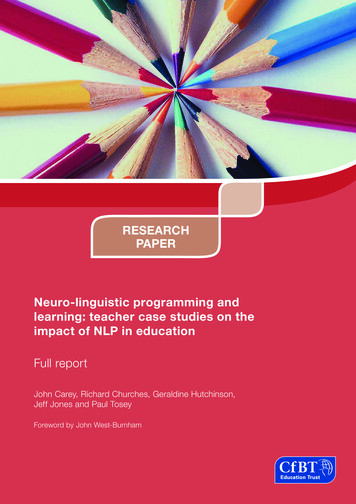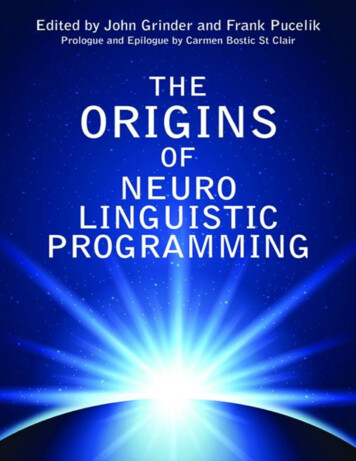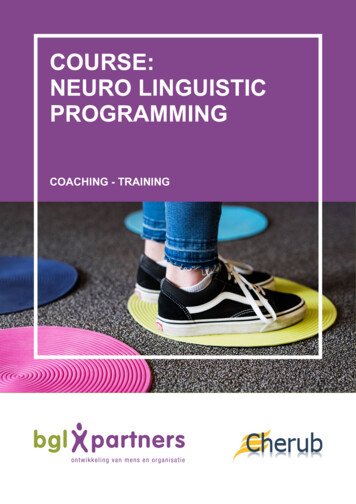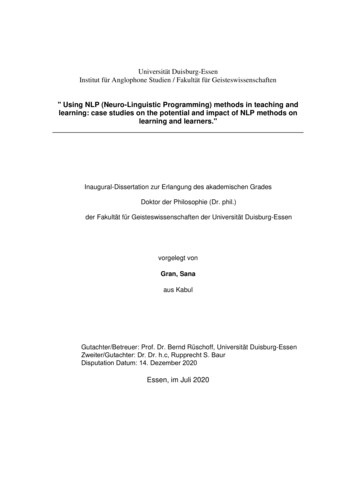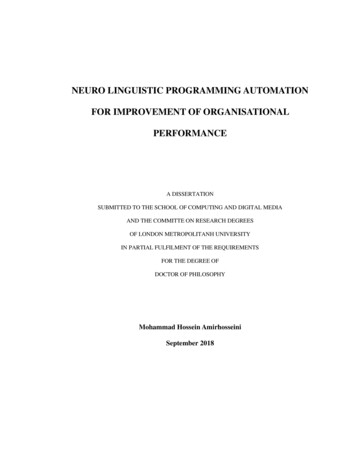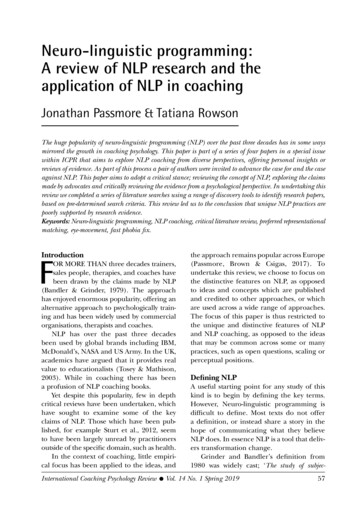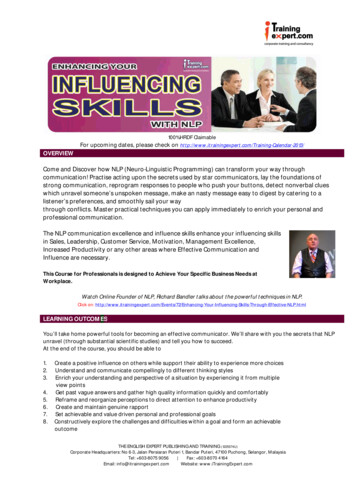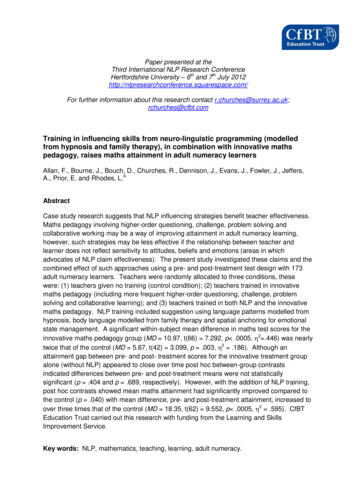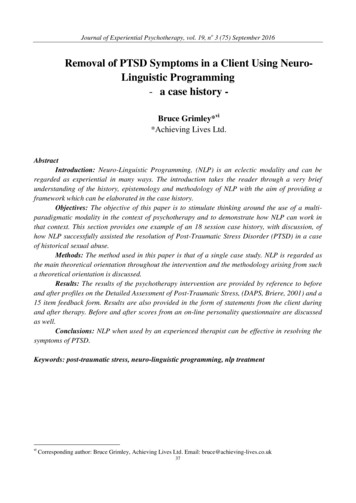
Transcription
ISSN 1799-2591Theory and Practice in Language Studies, Vol. 10, No. 9, pp. 1141-1147, September 2020DOI: istic Programming and Its Implications forEnglish Language Learners and TeachersNeda HedayatDepartment of Language Teaching and Translation, Varamin-Pishva Branch, Islamic Azad University, Varamin, IranReza RaissiDepartment of Language Teaching and Translation, Varamin-Pishva Branch, Islamic Azad University, Varamin, IranSolmaz Azizzadeh AslDepartment of Language Teaching and Translation, Varamin-Pishva Branch, Islamic Azad University, Varamin, IranAbstract—In the world we live in, education is praised as a base for training and nurturing future generationsand teaching is considered as a valuable profession through which future generations are flourished. The maincomponents of each educational system must work well in order to create a successful system and achieve thedesired results. Teachers are considered as one of the key determinant factors and active decision-makers ofany educational system. Learners are also taken into account as one of the main elements of the system whoare instructed to reach some educational goals. Neuro-linguistic programming (NLP), with high potential forEnglish teaching and learning, is regarded as a supplementary technique which helps the teachers to developoutstanding skills like critical thinking, self-efficacy, and rapport which are necessary to bring on success andachievement to the education and to support learners to achieve excellence in their performance. The articlefirst presents a brief history and definition of NLP. Then it is followed by some information about the mainpillars of neuro-linguistic programming. The discussion then turns to understanding some of the implicationsof NLP for English language teachers and learners and its potential for educational success.Index Terms—neuro-linguistic programming, learners’ success, teachers’ successI. INTRODUCTIONLanguage is at the heart of human being life. We use it to show our feelings, to reach our desired outcomes, to pray,or to express our ideas. Through language, we exchange our attitudes and experiences, plan our lives and formindividual and social identities. Some people are capable of doing things in more than one single language. Knowingmore than one language may mean having a chance to get educated, get a job, having the opportunity to immigrate toother countries, expand the cultural horizons, and talk to other people with different linguistic and cultural backgrounds.So we can claim that language is the most unique feature of the creature. In today’s globalized scenario, in which manypeople know more than one language, and with the technological developments which have made our world a globalvillage, acquiring the ability to communicate effectively has become obligatory. Learning English as the language ofinternational communication which enjoys the status of lingua franca has become necessary for anybody who wants tointeract and communicate with other individuals around the world.In the past decades, communicative competence and the interactive aspect of language were not emphasized by themethods and techniques used by language teachers. But nowadays, methods like communicative language teaching orCLT has become popular in most educational organizations. Neuro-linguistic programming has been recognized as atool which can help the English language learners to improve the communicative competence, presentation skills andbody language effectively (Siddiqui, 2018).As teachers are considered as the key components of the educational system who affect its success, so identifying theelements which help them in teaching profession is very important. NLP is regarded as a supplementary techniquewhich helps the teachers to develop outstanding skills necessary to bring on success to the education and to supportlearners to achieve excellence in their performance. It is also helpful for language teachers to establish a bettercommunication with the learners, strengthen the educational environment, and have a supportive and effectiveinteraction which leads to the higher academic achievement. The present article first presents a brief history anddefinition of neuro-linguistic programming and then it introduces the main pillars of NLP. In the next sections, some ofthe implications of NLP for English language teachers and learners are provided and discussed.II. NEURO-LINGUISTIC PROGRAMMINGNeuro-Linguistic Programming (NLP) is an interpersonal communication system, developed by John Grinder, anassociate professor of linguistics, and Richard Bandler, a mathematician and a graduate student of psychology, in theearly 1970s as a new method to language teaching. It is a collection of strategies, techniques, and patterns which are 2020 ACADEMY PUBLICATION
1142THEORY AND PRACTICE IN LANGUAGE STUDIESused for effective communication, growth, and personal change. The originators of NLP studied different patterns ofbeliefs and subjective experiences of the people with excellent behavior (Revell & Norman, 1997) in order to discoverthe structures of excellence. As they believe that all behaviors have some certain structures, and by discovering theexcellent patterns and modelling them, it is possible to repeat the same patterns and gain the same favorable results.Grinder and Bandler claim that neurological processes (N), language (L), and behavioral patterns learned throughexperience (P) are interconnected, and human beings can alter them and it is possible to change them to reach thedesired goals in life. As a matter of fact, neuro-linguistic programming consists of certain techniques forcommunication and personal development. Generally speaking, it is based on some notions about the structure of themind, the way it works, and the way individuals act and interact. Based on neuro-linguistic programming, human beingshould be taken into account as a whole mind-body interpersonal communication system with consistent, patternedconnections between three main areas: Neuro (neurological processes), Linguistic (language), and Programming(behavioral strategies. ‘Neuro’ reflects the neurological processes (or how the body and mind interact). In other words,it relates to the way you use senses to understand things and happenings around. The second element which is‘Linguistics’ is the matter of thought patterns and the language which is applied for interpersonal communication. Inother words, NLP accounts for the neurological processes through which we experience and process information by oursenses (auditory, visual, olfactory, kinesthetic, and gustatory). The other element, ‘Programming’, is the way we nurturethe mind through interpreting the patterns of an individual’s behavior and language use in order to reach the desiredresults. In other words, it is related to the ability to organize thoughts and ideas. The pragmatic approach of neurolinguistic programming uncovers important elements regarding the learners’ mind and thought process by evaluatingthe kind of language used by them in order to change thoughts and actions and reach the educational goals.Bandler (1985) claims that the experiences are sent, processed, and stored to the brain for which each person has aphysical location. One of the main skills of NLP is recognizing the way people think, as there is a belief that eachperson has a preferred sense of taking in information that should be discovered in order to help learners maximize theirlearning (Alamdar & Karbalaei, 2015). As NLP is taken into account the learning styles of students, so teachers shouldbe aware of all linguistic, physical, cognitive, and behavioral structures of the students which are demonstrated ininformation processing and learning through the aforementioned senses. In this sense, as Miller (1981) declares,teachers should stay tuned within the same channel of communication (visual, auditory, or kinesthetic) in order toestablish more effective communication with the learners.Another aspect of NLP is the special focus on brilliance and quality. Neuro-linguistic programming studies brillianceand quality. In other words, it studies the way successful and outstanding individuals and organizations reach their idealgoals. According to Siddiqui (2018), teachers can apply different techniques of NLP in order to analyze the kind oflanguage used by students and take into account the thought process of them. This knowledge helps them to becomecapable of changing thoughts and behaviors in a way that leads to desirable outcomes. According to the Bandler andGrinder’s point of view, NLP is ‘the psychology of excellence’ or ‘the art and the science of excellence’. They havestarted their studies based on the predisposition that some people do affairs in an excellent way while others don’t. Sothey started to find out what makes ‘outstanding performers’ outstanding, as they believe that all the individuals canbecome outstanding performers just by doing the same directions, irrespective of their past or present (Lady, 2007).Joanne Walter and Ardeshir Bayat call it “a process that can be applied to model excellence in any field” (Walter, Bayat,2003). As a matter of fact, the key driving force of NLP pioneers was discovering the mystery of excellence. Theproponents of neuro-linguistic programming do claim that excellence is not a natural talent and it is learnable (Walterand Bayat, 2003). They also assert that excellence is not rare and anybody can be equipped with this crucial property.The only thing which is required is that individuals free themselves from any limitations and take into account variouschoices.NLP is also considered as a supplementary tool applied in the field of second or foreign language instruction in orderto assist learners to become excellent performers. There is a belief that by understanding the process of HOW andREPEATING the same process the same result will be acquired, otherwise, we can CHANGE the whole process or partof it in order to reach another different result. While altering the process is regarded as behavioral change, repeating theprocess of doing something is called modeling. The idea of modeling is applicable in any aspect of life includingeducational settings. Revell and Norman (1997) introduce 13 important rules which should be a part of the teachers’belief system and shape the instruction procedure:1. Mind and body act as components of the same system which are interconnected and affect each other.2. All human beings have special maps of the world and these maps are not the territory.3. Failure doesn’t exist, only feedback. There is no such thing as failure and there is always another chance tobecome successful.4. When we do believe that something is true, the map becomes the territory. So it is either true or it becomes true.5. You should know exactly what do you want. This view will help you to get it.6. Any resource which is needed for our goals exists inside us.7. Communication has verbal and also nonverbal forms and it is not just limited to one of them.8. The unconscious mind is superior and kind.9. Communication has conscious and nonconscious forms. 2020 ACADEMY PUBLICATION
THEORY AND PRACTICE IN LANGUAGE STUDIES114310. All behaviors have a positive intention behind them.11. The meaning of communication is manifested by the response we get.12. We should model each excellent behavior in order to reach excellence.13. Flexibility is a crucial element of any system.III. PILLARS OF NEURO-LINGUISTIC PROGRAMMINGThere are four key pillars or principles for NLP (O’Connor and McDermott 1996; Revell and Norman 1997):1. Rapport: According to the Oxford dictionary, rapport is defined as “a close and harmonious relationship in whichthe people or groups concerned understand each other’s feelings or ideas and communicate well.” Webster (1984)describes rapport as a relationship marked by affinity, harmony, and accord. When the teacher and learners are inharmony or rapport, the teaching process becomes easier. As Delbio and Ilankumaran (2018) suggest, one of the mainpillars of neuro-linguistic programming is creating effective communication and it is believed that rapport is veryimportant in this regard, because it maximizes the similarities and minimizes the differences between individuals. It isbelieved that for developing rapport, teachers should develop behaviors similar to students which is possible through“mirroring”. Rapport is an empathy that is shaped subconsciously between individuals. As asserted by Silva (2017),strategies of NLP are effective in creating rapport or empathy and can be applied to make a closer relationship betweenteacher and student. Consequently, teachers can use them to provide a more supportive and fruitful learningenvironment which results in higher productivity and success. As we live with communities and we are not alone sohaving the ability to generate rapport and effective communication is a must. In this regard, we should shaperelationships with mutual trust and responsiveness.2. Outcome thinking: This pillar relates to individuals’ goals. It suggests that people should know what do they wantand set their goals clearly for themselves, as precision is a key to success. It is asserted that the more individuals areaware of their wants and desires, the more likely they will reach them. In other words, NLP is based on a premise thatprecision helps individuals to achieve their goals. So, we should know exactly “what we want”. There are five steps forthis rule: Appreciate your goal as an important and attractive desire, and make it as compelling as possible. Focus on your desired goal all day long, and set your mind on a path ending to your objective. So, you willpass the way much easier. Imagine that your dream has become true and you have already achieved your goal. Your visualization is veryimportant and you should draw a clear picture in your mind. Then, walk back and try out the path to yourdesired end. Concentrate on all the steps of the pathway. You should be aware of all resources, actions, and all theindividuals who help you through the way and take all of them into account. With new insight, step back to the present and take action to reach the goal.3. Sensory awareness: It is related to the idea that we use our senses to experience the world and to see, hear, or feelwhat is happening to us. When we use our senses, the feedback which is gained helps us to adjust our actions towardsreaching the desired goals.Sensory acuity or awareness means that by using senses, individuals become aware of the environment and thingsthat happen around. Based on NLP, this knowledge is very important for our success. In many cases, individuals used todo things without considering what works and what does not. When people try to reach their objectives, they must alsodevelop a level of awareness that enables them to distinguish between what is working (which helps them to reach thedesired outcome) and what is not.4. Behavioral flexibility: It is related to adaptability in the entire situation. It also means that when we have variouschoices of action, our chance of success increases. In order to reach different outcomes, we must change the way thingsare done. And according to NLP, we must keep changing the process until we get what we want. So flexibility inbehavior is a key to success. The science of Cybernetics has got a rule claiming that “in any system, the part with thegreatest range of freedom will be the one controlling the system.” Generally, one of the important directions of neurolinguistic programming is encouraging people to increase their behavioral flexibility and to be more adaptable indifferent situations and accept the changes in life.IV. IMPLICATIONS FOR THE LEARNERSNeuro-linguistic programming is believed to be an influential tool that affects the personal and educational life of thelearners. It has the potential to improve the life quality, develop positive attitudes, provide support to resolve thepsychological complications, help to make better decisions, establish effective communication, and foster languagelearning. As it is emphasized by García & Tamayo (2017), language learners can use NLP as a psychotherapeutictechnique to improve their performance and take a step towards achievement. One of the main implications of neurolinguistic programming is its assistance in the field of English language learning.Moharamkhani, Karimi, and Ahmadi (2016) have investigated the effect of neuro-linguistic programming onvocabulary learning and after 12 sessions of treatment by swish pattern which is one of the NLP strategies, they have 2020 ACADEMY PUBLICATION
1144THEORY AND PRACTICE IN LANGUAGE STUDIESconcluded that it has a significant effect of English language learners’ vocabulary achievement. The researcher of thisstudy point to the view that NLP is practical for all type of learners with different learning styles, consequently it can bea good choice for English classes. According to the originators of NLP, Bandler and Grinder (1985), swishing is aprocess by which the pattern of thought which leads to undesirable behavior is destroyed in order to be replaced byanother favorable behavior. The originators claim that this process necessitates the visualizing a cue which is related tothat undesirable behavior. The Swish pattern gives a new direction to the brain and the behavior goes after the samedirection, so the new wanted behavior is shaped. In this study, the researcher has used swishing elements such asstrategy introduction, practice, and feedback and followed these steps: context identification, cue identification, drawingthe ‘cue’ picture, and finally, swishing and testing. As an example, when the teacher wants to teach the word ‘habit’ tothe students, he or she asks students to imagine the hands of a smoker while smoking cigarettes and doing the bad habit.Then students are asked to repeat the words ‘habit’ and ‘bad habit’. After this part, students are asked to imagine ahealthy guy who looks fit and energetic and repeat the words ‘habit’ and ‘good habit’. Then, learners should changetheir mental picture from a smoker to a healthy guy (swish pattern) and say the word ‘habit’ repeatedly. Students areasked to talk about some good and bad habits they have, and make different sentences with the word ‘habit’. In thismanner, learners have visualized a specific outcome of a certain situation which leads to a bad habit and should beavoided. The repetitions and visualizations are continued at home after each session and they are discussed in the nextsession. After examining the results of the posttest, the researcher concludes that the NLP strategy is satisfactory and itcan be a very good strategy for vocabulary learning.According to Alamdar and Karbalaei (2015), NLP is a useful tool for increasing the self-esteem of English languagelearners. In the study, they have selected four classes and used old methods of language teaching for the control groupand NLP strategies and also old methods for the experimental group. The results of the study indicate that NLP is abeneficial tool to increase learners’ self-esteem. As they explain, speaking is the most challenging skill among fourskills of English learning and it needs a great deal of self-esteem and motivation. Neuro-linguistic programmingprovides some effective learning strategies and changes the limiting beliefs of the learners from “I cannot learn English”to “I can learn English”. The researchers of this study have selected some stories to connect culture and language. Lifelessons are used to build self-esteem and summary activities are also applied after reading or listening to the selectedstories. Visualization is another strategy of NLP, as there is a belief that when learners know what exactly they want,they will achieve it. So they are required to write down their objectives and follow the motion pictures. They shouldalso create some mental images through visualization for better retention and recall of information.In a study carried out by Farahani (2018), the effect of neuro-linguistic programming on reading comprehension ofEnglish ESP students has been investigated. The researcher has selected two intact groups with 30 participants in eachas an experimental and control group and has implemented NLP strategies for the reading skill of the experimental class.The results of the posttest which is drawn by ANCOVA clearly show that the implemented techniques have beensuccessful for the intended purpose. Ten passages are taken from a reference book with the title “Reading Science andMedicine in English” as the materials of the study. In one session, all eight selected techniques of NLP are explained forthe experimental group. The researcher has also clarified how to set objectives, what learning styles do exists, how touse senses in order to learn another language, and the effect of human emotions in language learning. After recognizingthe specific learning style, the students are asked to read the passages using their own style. As an example, auditorylearners read the passages aloud for themselves or listen to audio materials, or have some background music whilereading the passage. Instead, kinesthetic learners have some hand movements or try to write the information. Thiscategory is allowed to walk for a while if it helps to feel better or try role-play activities related to the content of the text.By informing the learners of their own sensory learning styles and also teaching reading NLP techniques related to thespecified styles, the researcher finally concluded that NLP strategies have a significant effect on ESP students’ readingcomprehension and this finding can be applied by English teachers in order to improve this essential skill of the learners.Pourbahreini (2015) has investigated the effect of neuro-linguistic programming on grammatical knowledge of EFLstudents. In her study, passive sentences are concentrated and 60 students are selected to examine the research question.After administrating different tests and homogenizing the participants, the intervention program which is teachingthrough NLP activities is applied. Strategies of NLP which are used for this purpose are anchoring, VAK or visualauditory-kinesthetic, role-play, and so on. Visual learners are taught in an entertaining fashion, and they work onpassive and active voices in pairs. The results show a great deal of difference between the pretest and posttest of theexperimental group. Therefore, the researcher has concluded that NLP can be a useful strategy for teachers and learnerswho work on the grammatical accuracy of the English language.V. IMPLICATION FOR TEACHERSEducation is one of the most important human activities and teachers are the most important influential elements inany educational system that helps learners to reach their objectives. Different studies over the last decades haveconfirmed that teachers have an essential effect on the students’ academic and life-long success (e.g., Chetty, Friedman,& Rockoff, 2014; Jackson, 2012; Nye, Konstantopoulos, & Hedges, 2004). There are many elements that help teachersin their valuable profession and enable them to do their best and become effective and successful teachers. Despite thefact that education, experience, and certification are related to the effectiveness of teachers, there are many critical skills 2020 ACADEMY PUBLICATION
THEORY AND PRACTICE IN LANGUAGE STUDIES1145and classroom activities that matter most to students’ achievement. Scholars believe that the main professionalresponsibility of teachers as educators is changing the behavior of students towards certain maturity and this process ispossible with a series of activities for which teachers have a decisive role. It is believed that neuro-linguisticprogramming is a very useful tool for the language teaching profession which can be applied as a supplementarytechnique to improve the effectiveness of the teachers (Gewasari, Manullang, and Sibuea, 2017). It provides strategiesfor language teachers and learners to change their unproductive learning habits and experience successful and effectivelanguage learning.According to Siddiqui (2018), anchoring, rapport building, metamodeling, and mirroring are some of the keyelements of neuro-linguistic programming which can help language teachers in performing a better teaching atmosphere.The researcher defines anchoring as a technique of NLP which shapes a positive mental image or attitude towardslearning with the assistance of anchors. In this way, special gestures, expressions, and body movements are createdwhich are the results of positive emotions and confident state of mind. It has been proved that anchoring is a veryeffective technique for language learning.Building rapport is also important for language learning (Delbio and Ilankumaran, 2018). As it is defined in theOxford dictionary, rapport is “a close and harmonious relationship in which the people or groups concerned understandeach other's feelings or ideas and communicate well.” Proponents of NLP stress that English language teachers shoulddo their best to establish rapport with their learners and thereby accelerate the learning process. In such a conductiveenvironment, any gaps in communication will be filled and effective interactions will be shaped. In general, when a safeand supporting learning environment is created, the confidence of the learners is increased and they get ready toaccomplish the assigned tasks and activities and they take a step towards their educational success (Comenius, 2009).Mirroring is another NLP technique that is applied in order to create effective communication (Siddiqui, 2018). NLPpractitioners claim that in order to establish rapport among language learners, gestures, postures, facial expressions,breathing patterns, etc. should be mirrored. Teachers can enhance verbal and non-verbal communication by using thesepatterns. Teachers should encourage learners to mirror behavioral patterns and language of fluent speakers in order toincrease their motivation and promote their presentation and speaking skills. Mirroring and modeling are the keystrategies of NLP which should be practiced to reach excellence. In this way, learners are assisted by the teachers tomodel the study patterns of successful performers in order to reach similar academic results. Therefore, as Siddiqui(2018) concludes, English language teachers can apply the strategies and techniques on neuro-linguistic programmingto make the language learning process more attractive and interesting. NLP strategies help English language teachers toact as facilitators and enhance the interpersonal and communicative skills of the learners and improve their personalityin a way that they can face the world with more confidence.Neuro-linguistic programming is based on neurology and communication. It is based on the view that human beingshave different learning styles and perceptual preferences which should be taken into account by language teachers. Inthe process of language learning, learners use their five senses which are called representational systems. They includeauditory (for listening or hearing something), visual (for looking and seeing), olfactory (for smelling), gustatory (fortasting), and kinesthetic (to feel internally and externally). One of the responsibilities of ELT teachers is recognizingthese features and deciding on optimal teaching solutions. Based on Pishgaman and Shayesteh (2014), when languageteachers pay more attention to these differences and provide more effective external and internal learning atmosphereand apply sensory reach language, they assist language learners to learn in a more productive and easy way. Morevariety in teaching is also another consequence of NLP application in language instruction (Winch, 2005). It is believedthat there is a lead system (neutral, auditory, visual, and kinesthetic) that should be recognized by the teachers andlearners to improve language learning effectiveness. Practitioners claim that language teachers are able to affect the waymaterials are used by the learners but they cannot affect the way learners store them. What is clear is that learners whoare aware of their lead system can use expressions in English consciously which are more in harmony with the way theyprocess and store the input. In order to identify the preferred learning style, practitioners suggest some questionnaireswhich can be used by teachers and learners. According to Winch (2005), eye movement and learners’ traits andbehaviors (including their verbal and non-verbal communication) are the clues delivered unconsciously and should betaken into account in order to recognize the learners’ tendencies. Eye movement is a sign which reveals the way aperson processes information. Looking right, left, or up is a sign of visual processing while looking either side or downis the indicator of kinesthetic processing, and looking to either side means an auditory style of processing information(Hamilton 2005; Revell and Norman 1997). Certain traits or behaviors are also considered to distinguish differentlearners based on their lead system (Robbins, 1997). As an example, using phrases like “That’s the way I see” is anindicator of a visual person. These people may talk with a high-pitched nasal voice and may have muscle tension in theupper part of the body especially abdomen and shoulders. The individuals with the auditory lead systems have a morebalanced tone than visual ones. They take a more deep breath and even muscle tension is more balanced in this category.Speech tone in kinesthetic individuals is deep and slow. When they start to speak with someone, they have frequentpauses. Strong and solid posture is the other trait of this category. Teachers who are aware of these preferredr
Neuro-linguistic programming (NLP), with high potential for English teaching and learning, is regarded as a supplementary technique which helps the teachers to develop outstanding skills like critical thinking, self-efficacy
